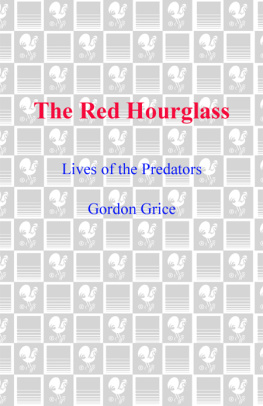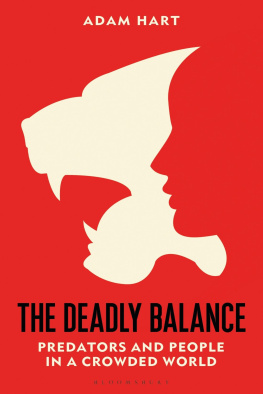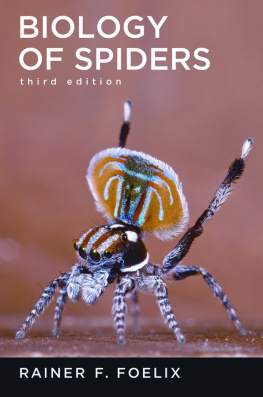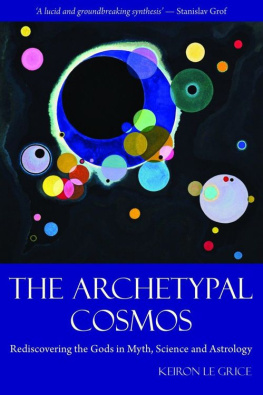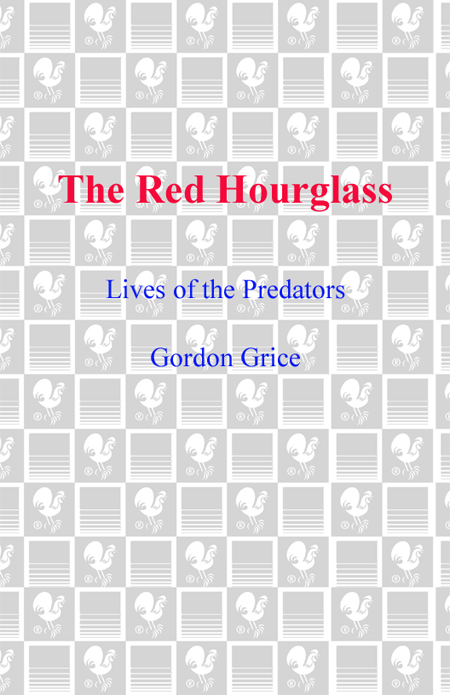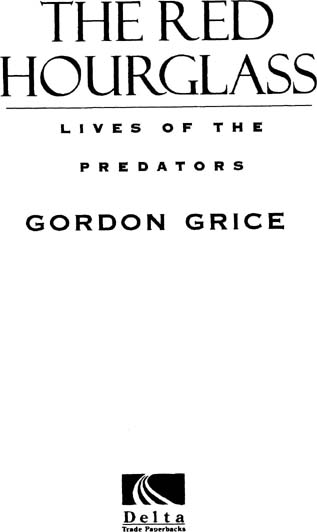PAISE FOR GORDON GRICES
THE RED HOURGLASS
A precise and savage blow aimed at our predatory
supremacyI wolfed it down.
Will Self, author of Great Apes and
Grey Area: And Other Stories
Grice is one hell of a writer. I was originally disturbed by some of the killing he depicts, but his descriptions are so compelling that I had to read on. Im glad I did
The Red Hourglass is an absolutely first-rate book.
Jeffrey Masson, author of
When Elephants Weep and Dogs Never Lie About Love
FASCINATING FIRST-RATE WONDERFULLY UNSENTIMENTAL.
The New York Times
The most interesting collection of essays Ive read in years Dont be put off by the subject, unless you have certain phobias, otherwise youll miss Grices fine eye for detail, his graceful writing style and a droll, dark sense of humor.
Arkansas Democrat Gazette
AN ABSOLUTELY SPELLBINDING BOOK.
Elle
Gordon Grices essays hold the reader in their spell,
and then carry him beyond the usual romance
of the insect and animal world to something darker
and far more interesting: Natures Gothic. The Red
Hourglass marks the debut of a fresh, strange,
and wonderful new voice in American
nature writing.
Michael Pollan, author of
A Place of My Own and Second Nature
Please turn the page for more extraordinary acclaim.
ELEGANT, AND WRYLY FUNNY.
Esquire
GRICES FUSION OF SCIENTIFIC AND LITERARY GIFTS converts dangerous and ugly predatorsincluding tarantulas, rattlesnakes, black widow spiders, and jungle pigsinto objects of fascination. He weaves an experts knowledge of biology into an engrossing tapestry of personal narrative and philosophical reflection. Inviting comparisons with the work of Lewis Thomas and Peter Medawar, this book will delight those interested in either animals or literature.
Booklist
DELIGHTFUL Grice writes with
ironic humor.
amazon.com
A deceptive little book that takes readers into
a world few imagine Grice [writes] with a
fascination both of horror and delight.
The Denver Post
FIRST-RATE Feisty, felicitous prose.
Publishers Weekly
Reading his book is like spending a few hours in the House of Fright: fun, yes, but hair-raising.
The stories can be gruesome, but they grip you because Grice never blinks. But the quality of his attention to the facts of life and his willingness to look the awful and the repellent straight in the eyes will earn your admiration.
Mens Journal
For Tracy, Parker, and Abilene
Many people shared experiences and expertise with me as I researched this book; I thank them all. Im especially grateful to David Grice, Michael Ridgway, and Michael Gabriel, whose experiences were particularly helpful; Steve Ridgway, who got me into many of these adventures; Pat Krause, who generously supplied me with information on Dr. Allan Blair; William Harrison, who shaped my first attempts to write about the black widow; Elyse Cheney, my agent, who came up with the idea for this book; and James Twiggs, who gives me my best advice.
CONTENTS
BLACK WIDOW
I hunt black widow spiders. When I find one, I capture it. I have found them in discarded car wheels and under railroad ties. I have found them in house foundations and cellars, in automotive shops and tool-sheds, against fences and in cinder block walls. As a boy I used to lift the iron lids that guarded underground water meters, and there in the darkness of the meter wells I would often see something round as a flensed human skull, glinting like chipped obsidian, scarred with a pair of crimson triangles that touched each other to form an hourglass: the widow as she looks in shadow. A quick stir with a stick would trap her for a few seconds in her own web, long enough for me to catch her in a jar.
When I walk the paved paths in a certain landscaped park in my hometown, a hot day will sometimes show me a sparkle that vanishes with any slight change of angle, and near it some windblown garbage will be lodged in the crags of a piece of granite or in the sandy dirt gathered by a prickly pear. A minutes investigation reveals that garbage, stone, cactus, and earth are all held together by an almost invisible web, at the corner of which the clawed tips of a black widows sleek legs protrude from some crevice. To catch a widow in this situation, I have to find a live insect and toss it into her web. Only after she has come out to kill the insect and is lost in the business of biting and wrapping do I have a good chance of catching her; otherwise, she is too quick to retreat to her hiding place.
In the dry Oklahoma Panhandle, I found one under the threshold of my back door. It thrust its forelegs into the kitchen to threaten the pencil I prodded it with. Years later, when I lived in the humid Ozark Mountains of Arkansas, my wife and I had taken a new apartment, and a second before Tracy sat down on our new threshold I recognized those black lines, which might have been cracks in the cement, as a widows legs: I yanked the spider out and captured it in a coffee can.
I have found widows on playground equipment, in a hospital, in the lair of a rattlesnake, and once on the bottom of the lawn chair I was sitting in as I looked at some widows I had captured elsewhere that day.
Sometimes I raise a generation or two in captivity. The egg sacs contain multitudes of pinpoint cannibals. Growing for several days on the residual energy of the egg yolk they consumed before hatching, they molt before ever eating. The mass of them appears as a dirty cloud at the center of the egg sac, gradually expanding into a visibly moving stain that fills the sac. They live in their private sphere for about five days before they venture out into the world through a single, perfectly round hole chewed by one precocious sister, and as they leave they trail fine silk that gleams with the sun, the group of them producing a glimmering tangle like a model of an electron cloud, the empty sac its nucleus. After a day in that tight formation, they drift away from each other.
They grow rapidly, the most successful eaters shucking a skin every few days. They begin as swirls of light brown and cream, then darken with each molt, resolving into brown with white spots. A white hourglass is soon clear on the belly. In the females, a pale orange hue dawns in the center of the hourglass with succeeding molts; the brown rapidly darkens. The orange deepens to red, like a sunset, and spreads outward to infect the entire hourglass. As adults their black is broken only by the crimson hourglass and, depending on the individual, perhaps a few other specks or stripes of red or a white dot. The male may retain his infant colors, or he may grow black and sport a psychedelic array of red, gold, and white marks.
I separate the siblings before they mature, usually when three or four remain from the original cannibal brood. Its not chance that causes these few to survive. From the beginning they were bigger, stronger, more aggressive than their sibs, and grew faster. Wild widows eat nothing for the first few days except each other; even in captivity, given plenty of small insects, the spiders prefer the taste of their sibs. The teeming masses of humbler spiderlings exist to feed the voracious few. Now I feed these few on bigger game, starting with houseflies and mosquitoes and progressing to larger insects such as crickets and bumblebees.
But I dont dare open the container until they have done their culling.

